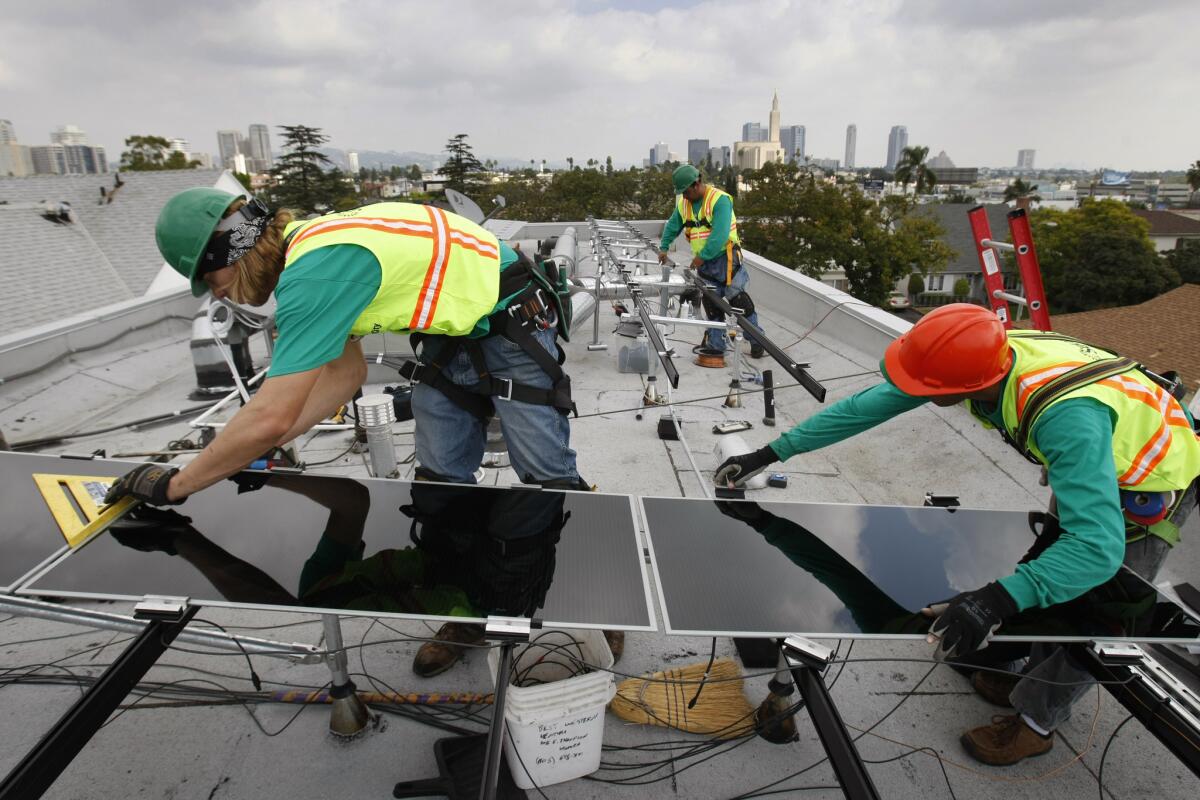Whole Foods teaming with NRG and Solar City to install rooftop solar at 100 stores

SolarCity employees install solar panels on a West Los Angeles home in 2009. Whole Foods Markets has struck deals with SolarCity and NRG to install rooftop solar energy systems at up to 100 of its stores and distribution centers.
- Share via
Whole Foods Market Inc. is embracing solar power.
The Austin, Texas-based grocery chain has signed agreements with SolarCity and NRG Energy Inc. to install rooftop solar units at up to 100 stores and distribution centers.
NRG, based in Princeton, N.J., will install the units at up to 84 locations in nine states, according to a joint statement from the two companies.
San Mateo, Calif.-based SolarCity will install the rest, Whole Foods spokeswoman Blaire Kniffin said.
See more of our top stories on Facebook >>
The companies did not disclose the locations of the stores that will receive the rooftop solar units, but Kathy Loftus, Whole Foods’ global leader for sustainability, said the company’s goal was to have rooftop solar units in every region.
In a statement, Whole Foods said it would buy discounted power from SolarCity.
Why did Whole Foods strike deals with both NRG and SolarCity? “If we were only going to go with one or the other, we would be limited,” Loftus said. “Working with both, we increase the volume and geographical markets.”
Whole Foods says it currently has rooftop solar installed at 20 stores. Tuesday’s announcement comes 14 years after the chain installed solar-powered lighting for the first time, at a store in Berkeley. Installation of the newly announced solar units will begin in the spring, Loftus said.
She said SolarCity install more systems for Whole Foods in the future.
Whole Foods has 439 stores in the U.S., Canada and Britain.
A store’s rooftop solar unit can generate about 5% to 20% of the yearly electricity that store needs, Loftus said.
“We think this is a good way also to be protecting against potential future energy cost increases,” she said. “We’re doing what’s right for the environment, but we’re also doing what’s right for the business.”
Last month, SolarCity reported disappointing fourth-quarter earnings, with a larger-than-expected loss of nearly $232 million and a slower rate of installations than initially anticipated.
SolarCity Chief Executive Lyndon Rive said those results were caused in part by delays in commercial solar projects.
For more business news, follow @smasunaga.
SIGN UP for the free California Inc. business newsletter >>
ALSO
How and when to install a rooftop solar system
Solar City stock, already down more than 60% this year, continues to dive
California solar owners face new fees, utilities say costs should be higher
More to Read
Inside the business of entertainment
The Wide Shot brings you news, analysis and insights on everything from streaming wars to production — and what it all means for the future.
You may occasionally receive promotional content from the Los Angeles Times.











